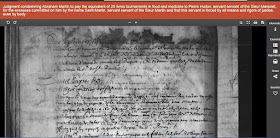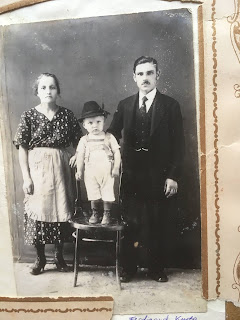 |
| Rue Saint Louis. The street where Anne Greslon inherited property. |
The first French Canadian family history research resources I was introduced to when I started my research 20 years ago were the the Catholic Church records and Census records. I then moved to some of the Jesuit writings and wills. I've also used Familysearch.org notarial records on film and digitized to fill in missing documentation.
A few months ago I was able fill in some additional information regarding my Mason/Masson great-grandparents using the resources I already knew about. The problem finding them in the past involved indexing errors. These records are now showing up when I enter their names because someone has corrected these errors at Ancestry.ca.
I had no idea when my ancestors Pierre Masson and Aurelie Lambert died until this year when the Census index was corrected at Ancestry.ca.
In the 1871 Census for Quebec, Canada we indeed find Aurelie misspelled Orilie. Finding this record confirmed to me that the Pierre Masson and Aurelie Lambert were still living in Quebec, and in the same area as in 1851. It appears their son is living close to the couple because their son Augustin Masson is the next entry on this Census record.
Not finding this couple in the 1871 and 1881 Census for Canada, previously, I assumed they probably migrated to maybe New England? I didn't find them in the Catholic Church death records which seemed to support a migration away from the Quebec area at least. Armed with the new information I now focused on finding a death record in Canada.
I did locate Pierre Masson's Catholic Church death record. I was not able to locate it before because his name was mistakenly indexed as Pierre Mallon. He died on 20 Feb 1889 in the family area of Riviere-Du-Loup (Louiseville), Quebec, Canada. If I had paged through the books instead of relying on the index I would have found it. The entry is definitely for my Pierre Masson because it states that his wife was Aurelie Lambert.
Pierre's widow Aurelie Lambert died fairly soon after her husband on 19 Aug 1890, in St-Barnabé-Nord, Maskinongé, Québec, Canada. She was living with family in that area after her husband died.
I had wondered if this couple had followed their son, my ancestor Pierre Masson/Peter Mason to America, now I know they didn't. I actually did page through the death records for St-Leon-le-Grande, but Pierre's death occurred in a neighboring parish and Aurelie died in an area I had never heard of before.
The Library and National Archives of Quebec online
Recently I was introduced to some new resources searchable online. This site "BAnQ's" contains digitized copies of early Quebec records including notarial records. I found many interesting family records which fill in the stories of my ancestors lives in Quebec, and provide more documentation for may family tree.
Some of the book resources I've found helpful:
- Inventory of wills, donations and inventories of the French regime kept at the Archives judiciaires de QuébecVolume 1
- Inventory of wills, donations and inventories of the French regime kept at the Archives judiciaires de Québec Volume 2
- Inventory of wills, donations and inventories of the French regime kept at the Archives judiciaires de Québec Volume 3
The 27 volumes of "Inventory of the registries of the notaries of the French Regime" is also an important book collection.
The most important collection is the Archives Textuelles which has been digitized. An important archival collection online is the "collection Pièces judiciaires et notariales".
If you have some specific information about a notarial document you are looking for you may be able to find the document here: Archives des notaires du Québecdes origines à 1937 . Ancestry.ca also has notarial documents which are easier to search for, but I have not found everything I've been looking for there. The notarial records are very helpful because they record marriage contracts and can be used for documentation when church marriage records are missing.
I found a land transaction in a book digitized by BAnQ's. I wish I had seen it before visiting Quebec. I may have seen something about this land transaction before, but it slipped my mind? My ancestor Anne Greslon a widow, and her first husband owned land in the upper town of Quebec City. The land was located on the main thoroughfare of the city, on Rue Saint Louis. I stayed in a hotel on that street during my visit in August. Anne's second husband, Jean Masson, was my ancestor and he assisted her in selling this land after they married.
From the same records I discovered my ancestor Jean Masson worked as a miller, which seemed to be a family occupation. He had some business contract disputes with customers as recorded in these records.
I loved touring the Chateau-Richer area, and felt pride in the fact I had an ancestral connection to that place. Little did I know at the time my own ancestors were thrown out of that place.
Here is a bit more about the case of my ancestor Jeanne Vignaude: "Trial of Jeanne Vignault, wife of Jacques Greslon dit Laviolette, resident of Beaupré coast, Jeanne Greslon, wife of Pierre Dasylva dit LePortugais (Portuguese), daughter of said Greslon and Vignault, Madeleine Larcher, wife of Elie Voisin, seaman, and Jeanne Olivier, wife of André Leroux, tailor, accused of scandal; mention is made of the interrogations of the accused, it is ordered that the said Larcher and Vignault will be questioned again, the said accused Vignault, Greslon, Larcher and Olivier are convicted of having led a bad life and causing a public scandal to the city, are condemned to leave the said city, and the name Jacques Dubord, quoted in two interrogations, is called to tell the truth" I'm not sure what this group of women did? Whatever they did these families did indeed leave the area.
I also found a land record for my ancestor Abraham Martin.
I noticed Scholastique was a popular name in one family. Saint Scholastica was Patroness of Benedictine women's communities; school; tests; books; reading; convulsive children; nuns; invoked against storms and rain. Scholastique Lambert was Marie Masson's godmother and aunt.
I'm adding godparents to baptismal notes using Rootsmagic.
I also often refer to the online records at Familysearch.org when trying to find documentation for my French Canadian ancestors.
From the same records I discovered my ancestor Jean Masson worked as a miller, which seemed to be a family occupation. He had some business contract disputes with customers as recorded in these records.
I loved touring the Chateau-Richer area, and felt pride in the fact I had an ancestral connection to that place. Little did I know at the time my own ancestors were thrown out of that place.
Here is a bit more about the case of my ancestor Jeanne Vignaude: "Trial of Jeanne Vignault, wife of Jacques Greslon dit Laviolette, resident of Beaupré coast, Jeanne Greslon, wife of Pierre Dasylva dit LePortugais (Portuguese), daughter of said Greslon and Vignault, Madeleine Larcher, wife of Elie Voisin, seaman, and Jeanne Olivier, wife of André Leroux, tailor, accused of scandal; mention is made of the interrogations of the accused, it is ordered that the said Larcher and Vignault will be questioned again, the said accused Vignault, Greslon, Larcher and Olivier are convicted of having led a bad life and causing a public scandal to the city, are condemned to leave the said city, and the name Jacques Dubord, quoted in two interrogations, is called to tell the truth" I'm not sure what this group of women did? Whatever they did these families did indeed leave the area.
I also found a land record for my ancestor Abraham Martin.
Abraham Martin is named in a court document in 1664.
The heirs of Abraham Martin go to court over his estate in 1664.
I also found a record referring to an inventory of the late Abraham Martin's movables in notarial records. The inventory was performed on 7 October 1664.
Nichols Perillard appears several times in these records. A man by that name was sent to the Royal Prisons. I'm not sure what his relationship to my family is? I believe he is related however.
My own ancestors Nicholas Perillard and Marie Sabourin, and their family, of Montreal also appear in these records. A tutor was hired for their children which resulted in the drawing up of several documents.
The heirs of Rene Alary and Louise Thibault were named in a court record in the Banq collection.
I have no record of birth for Marie Louise Houde who married Charles Lemay so it's nice to have additional documentation regarding her parentage from a court record generated after her parents death. The children of Louis Houde and Madeleine Boucher were listed as heirs, along with their spouses, on a document settling the family estate. I'm seeing a bit of a problem here because I have Marie Louise Lemay's death occurring in the year 1713 but this document appears to suggest she died before 1712?
Genealogie Quebec
I've also used the catholic church records at Genealogie Quebec. I found this site a good place to identify the children of a couple and collect their records. The ability to search by couple allowed me to more easily collect the records of siblings. I'm finding the witnesses and godparents in these records are helpful because they often include extended family members. It can be important as circumstantial evidence in cases where you are uncertain about relationships because names are spelled wrong, or dit names are used.
Sometimes you find famous godparents such as Samuel Champlain acting as a godparent of a relative. Abraham Martin and Marguerite Langlouis's daughter Helene's godfather was Samuel Champlain.
Below we see the grandfather of Marguerite Pare is her godfather. Aunts and Uncles are also often godparents.
I'm adding godparents to baptismal notes using Rootsmagic.
Familysearch.org online records for Quebec
I also often refer to the online records at Familysearch.org when trying to find documentation for my French Canadian ancestors.
Now that I've collected up witnesses and godparents I'm much more confident regarding the accuracy of my family tree. I wondered how the PRDH was able to reconstruct families when so many of the records are so difficult to read and there are many misspellings of names, and changing dit names? After collecting up the family records I've noticed how small the population was in many communities. Recognizing surnames and families becomes easier once you've become familiar with the local surnames.
My research on my French Canadian ancestors has moved forward a great deal since my visit to Quebec in August. The trip inspired me to continue to research the records for more information about my family. I now have a better picture of the lives of my French Canadian ancestors.
Merry Christmas and Happy Holidays to everyone!
Joyeux Noël!
My research on my French Canadian ancestors has moved forward a great deal since my visit to Quebec in August. The trip inspired me to continue to research the records for more information about my family. I now have a better picture of the lives of my French Canadian ancestors.
Merry Christmas and Happy Holidays to everyone!
Joyeux Noël!





























































